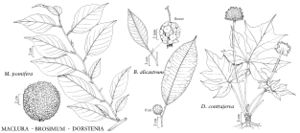Maclura
Gen. N. Amer. Pl. 2: 233. 1818, name conserved.
| Taxon | Illustrator ⠉ | |
|---|---|---|
 | Dorstenia contrajerva Brosimum alicastrum Maclura pomifera | John Myers John Myers John Myers |
Trees, deciduous; sap milky. Branches with axillary spines. Terminal buds surrounded by bud-scales. Leaves alternate; stipules caducous, free. Leaf-blade ovate to lanceolate, not leathery, margins entire, never lobed; venation pinnate. Inflorescences: flowers borne outside receptacle; staminate inflorescences loose short racemes; pistillate inflorescences dense heads. Flowers: staminate and pistillate on different plants. Staminate flowers: calyx 4-lobed; stamens 4, inflexed; filaments filiform; anthers introrse, with short connective. Pistillate flowers: sepals 4, 2 outer sepals wider than inner ones; ovary 1, superior, 1-locular; style unbranched, filiform. Syncarps globose, 8-12 cm or more diam.; each achene completely enclosed by its enlarged, fleshy calyx.
Discussion
Species 1 (1 in the flora).
Maclura is a monotypic genus endemic to North America.
Selected References
None.
Lower Taxa
"wider" is not a number.